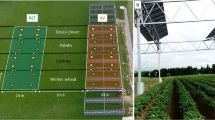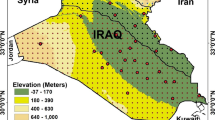Abstract
Air temperature (Ta) is commonly used for modeling rice phenology. However, since the growing point of rice is under water during the vegetative and the early part of the reproductive period, water temperature (Tw) is likely to have a greater influence on crop developmental rates than Ta during this period. To test this hypothesis, we monitored Tw, Ta, and crop phenology in three commercial irrigated rice fields in California, USA. Sampling locations were set up on along a transect from the water inlet into the field. (Water warms up as it moves into the field.) Ta averaged 22.7 °C across sampling locations within each field, but average seasonal Tw increased from 22 °C near the inlet to 23.4 °C furthest away from the inlet. Relative to Tw furthest from the inlet, low Tw near the inlet delayed time to panicle initiation (PI 5 days) and heading (HD 8 days) and the appearance of one yellow hull on the main stem panicle (R7 9 days). Using Tw instead of Ta when the active growing point is under water until booting (midway between PI and HD) in a thermal time model improved accuracy (root-mean-square error, RMSE) for predicting time to PI by 2.5 days and HD by 1.6 days and R7 by 1.8 days. This model was further validated under more typical field conditions (i.e., not close to cold water inlets) in six locations in California. Under these conditions, average Tw was 2.6 °C higher than Ta between planting and booting, primarily due to higher daily maximum Tw values. Using Tw in the model until booting improved RMSE by 1.2 days in predicting time to HD. Using Tw instead of Ta during this period could improve the accuracy of rice phenology models.





Similar content being viewed by others
References
Alocilja EC, Ritchie JT (1991) A model for the phenology of rice. In: Hodges T (ed) Predicting crop phenology. CRC Press, Boca Raton, pp 181–189
Awan MI, van Oort PAJ, Bastiaans L, van der Putten PEL, Yin X, Meinke H (2014) A two-step approach to quantify photothermal effects on pre-flowering rice phenology. Field Crops Res 155:14–22
Bouman BAM, van Laar HH (2006) Description and evaluation of the rice growth model ORYZA2000 under nitrogen-limited conditions. Agric Syst 87(3):249–273
Confalonieri R, Mariani L, Bocchi S (2005) Analysis and modelling of water and near water temperatures in flooded rice (Oryza sativa L.). Ecol Model 183(2–3):269–280
Counce PA, Keisling TC, Mitchell AJ (2000) A uniform, objective, and adaptive system for expressing rice development. Crop Sci 40(2):436–443
Counce PA, Siebenmorgen TJ, Ambardekar AA (2015) Rice reproductive development stage thermal time and calendar day intervals for six US rice cultivars in the Grand Prairie, Arkansas, over 4 years: rice reproductive development stage intervals. Ann Appl Biol 167(2):262–276
De Datta SK (1981) Principles and practices of rice production. Int. Rice Res. Inst., Los Baños
Espe MB, Yang H, Cassman KG, Guilpart N, Sharifi H, Linquist BA (2016a) Estimating yield potential in temperate high-yielding, direct-seeded US rice production systems. Field Crops Res 193:123–132
Espe MB, Cassman KG, Yang H, Guilpart N, Grassini P, Van Wart J, Anders M, Beighley D, Harrell D, Linscombe S, McKenzie K (2016b) Yield gap analysis of US rice production systems shows opportunities for improvement. Field Crops Res 196:276–283
Gao LZ, Jin ZQ, Li L (1987) Photo-thermal models of rice growth duration for various varietal types in China. Agric For Meteorol 39(2):205–213
Gao L, Jin Z, Huang Y, Zhang L (1992) Rice clock model—a computer model to simulate rice development. Agric For Meteorol 60(1):1–16
Hijmans RJ, Condori B, Carrillo R, Kropff MJ (2003) A quantitative and constraint-specific method to assess the potential impact of new agricultural technology: the case of frost resistant potato for the Altiplano (Peru and Bolivia). Agric Syst 76(3):895–911
Jones JW, Hoogenboom G, Porter CH, Boote KJ, Batchelor WD, Hunt LA, Wilkens PW, Singh U, Gijsman AJ, Ritchie JT (2003) The DSSAT cropping system model. Eur J Agron 18(3):235–265
Kuwagata T, Hamasaki T, Watanabe T (2008) Modeling water temperature in a rice paddy for agro-environmental research. Agric For Meteorol 148(11):1754–1766
Mall RK, Aggarwal PK (2002) Climate change and rice yields in diverse agro-environments of India. I. Evaluation of impact assessment models. Clim Change 52(3):315–330
Ohta S, Kimura A (2007) Impacts of climate changes on the temperature of paddy waters and suitable land for rice cultivation in Japan. Agric For Meteorol 147(3–4):186–198
Roel A, Mutters RG, Eckert JW, Plant RE (2005) Effect of low water temperature on rice yield in California. Agron J 97(3):943
Sameshima R (2004) Predicition of paddy rice development in northern Japan by models without consideration of water temperature. J Agric Meteorol Jpn 60(1):67–75
Satake T, Lee SY, Koike S, Kariya K (1988) Male sterility caused by cooling treatment at the young microspore stage in rice plants. XXVIII. Prevention of cool injury with the newly devised water management practices. Effects of the temperature and depth of water before the critical stage. Jpn J Crop Sci 57(1):234–241
Sharifi H, Hijmans RJ, Hill JE, Linquist BA (2017) Using stage-dependent temperature parameters to improve phenological model prediction accuracy in rice models. Crop Sci 57:444–453. https://doi.org/10.2135/cropsci2016.01.0072
Shimono H, Hamasaki T, Iwama K (2002) Response of growth and grain yield in paddy rice to cool water at different growth stages. Field Crops Res 73(1):67–79
Shimono H, Hasegawa T, Fujimura S, Iwama K (2004) Responses of leaf photosynthesis and plant water status in rice to low water temperature at different growth stages. Field Crops Res 89(1):71–83
Shimono H, Hasegawa T, Moriyama M, Fujimura S, Nagata T (2005) Modeling spikelet sterility induced by low temperature in rice. Agron J 97(6):1524
Shimono H, Hasegawa T, Iwama K (2007a) Modeling the effects of water temperature on rice growth and yield under a cool climate. Agron J 99(5):1327
Shimono H, Okada M, Kanda E, Arakawa I (2007b) Low temperature-induced sterility in rice: evidence for the effects of temperature before panicle initiation. Field Crops Res 101(2):221–231
Tanaka M (1962) Studies on the growth injuries of lowland rice caused by cool water irrigation and delayed heading. Jpn Engl Abstr Bull Aomori Agric Exp Stn 7:1–107
van Ittersum MK, Cassman KG, Grassini P, Wolf J, Tittonell P, Hochman Z (2013) Yield gap analysis with local to global relevance—a review. Field Crops Res 143:4–17
van Wart J, Kersebaum KC, Peng S, Milner M, Cassman KG (2013) Estimating crop yield potential at regional to national scales. Field Crops Res 143:34–43
Wang W, Yu Z, Zhang W, Shao Q, Zhang Y, Luo Y, Jiao X, Xu J (2014) Responses of rice yield, irrigation water requirement and water use efficiency to climate change in China: historical simulation and future projections. Agric Water Manag 146:249–261
White MA, de Beurs KM, Didan K, Inouye DW, Richardson AD, Jensen OP, O’Keefe J, Zhang G, Nemani RR, van Leeuwen WJD, Brown JF, de Wit A, Schaepman M, Lin X, Dettinger M, Bailey AS, Kimball J, Schwartz MD, Baldocchi DD, Lee JT, Lauenroth WK (2009) Intercomparison, interpretation, and assessment of spring phenology in North America estimated from remote sensing for 1982–2006. Glob Change Biol 15(10):2335–2359
Yao F, Xu Y, Lin E, Yokozawa M, Zhang J (2007) Assessing the impacts of climate change on rice yields in the main rice areas of China. Clim Change 80(3–4):395–409
Yin X, Kropff MJ (1998) The effect of photoperiod on interval between panicle initiation and flowering in rice. Field Crops Res 57(3):301–307
Yin X, Kropff MJ, Goudriaan J (1996) Differential effects of day and night temperature on development to flowering in rice. Ann Bot 77(3):203–213
Yin X, Kropff MJ, Horie T, Nakagawa H, Centeno HG, Zhu D, Goudriaan J (1997) A model for photothermal responses of flowering in rice I. Model description and parameterization. Field Crops Res 51(3):189–200
Zhang S, Tao F (2013) Modeling the response of rice phenology to climate change and variability in different climatic zones: comparisons of five models. Eur J Agron 45:165–176
Acknowledgements
The research was funded in part by California Rice Research Board. We would like to thank the Agroecosystems Laboratory at the University of California Davis and in particular Cesar Abrenilla. We also acknowledge the California Cooperative Rice Research Foundation Incorporated’s Rice Experiment Station, for their support during this study.
Author information
Authors and Affiliations
Corresponding author
Rights and permissions
About this article
Cite this article
Sharifi, H., Hijmans, R.J., Hill, J.E. et al. Water and air temperature impacts on rice (Oryza sativa) phenology. Paddy Water Environ 16, 467–476 (2018). https://doi.org/10.1007/s10333-018-0640-4
Received:
Revised:
Accepted:
Published:
Issue Date:
DOI: https://doi.org/10.1007/s10333-018-0640-4




